
ORP Orzeł was an Orzeł class submarine of the Polish Navy that served during WWII.

River monitors are military craft designed to patrol rivers.

The Baltic Sea campaigns were conducted by Axis and Allied naval forces in the Baltic Sea, the Gulf of Bothnia, the Gulf of Finland and the connected lakes Ladoga and Onega on the Eastern Front of World War II. After early fighting between Polish and German forces, the main combatants were the Kriegsmarine and the Soviet Navy, with Finland supporting the Germans until 1944 and the Soviets thereafter. The Swedish Navy and merchant fleet played important roles, and the British Royal Navy planned Operation Catherine for control of the Baltic Sea and its exit choke point into the North Sea.

ORP Sokół was a U-class submarine built by Vickers-Armstrong at Barrow-in-Furness. Shortly after launching in September 1940 she was to be commissioned by the Royal Navy as HMS Urchin, but instead was leased to the Polish Navy due to a lack of experienced submarine crews. A sister boat to Dzik, both boats operated in the Mediterranean from Malta, where they became known as the "Terrible Twins".

The six Leningrad-class destroyer leaders were built for the Soviet Navy in the late 1930s. They were inspired by the contre-torpilleurs built for the French Navy. They were ordered in two batches of three ships each; the first group was designated Project 1 and the second Project 38. These ships were the first large vessels designed and built by the Soviets after the October Revolution of 1917.
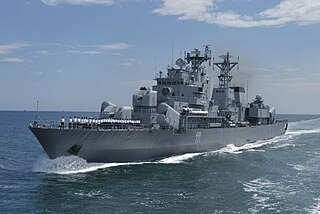
Mărășești (F111) is a frigate currently serving with the Romanian Navy. Mărășești served as the flagship of the navy between 1985–2004, when Regele Ferdinand became the new flagship. She is the largest warship of the Romanian Navy ever built in Romania.

Russian cruiser Varyag, formerly Chervona Ukraina, is the third ship of the Slava-class of guided missile cruisers built for the Soviet Navy now serving the Russian Navy.

The Soviet evacuation of Tallinn, also called Juminda mine battle, Tallinn disaster or Russian Dunkirk, was a Soviet operation to evacuate the 190 ships of the Baltic Fleet, units of the Red Army, and pro-Soviet civilians from the fleet's encircled main base of Tallinn in Soviet-occupied Estonia during August 1941. Near Juminda peninsula Soviet fleet ran into minefield that had been laid by the Finnish and German navies, and were repeatedly attacked by aircraft and torpedo boats, incurring major losses.
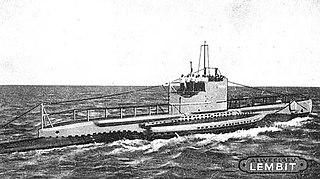
EML Lembit is one of two Kalev-class mine-laying submarines built for the Republic of Estonia before World War II, and is now a museum ship in Tallinn. She was launched in 1936 at Vickers-Armstrongs, Barrow-in-Furness, and served in the Estonian Navy and the Soviet Navy. Until she was hauled out on 21 May 2011, Lembit was the oldest submarine still afloat in the world. Her sister ship, Kalev, was sunk in October 1941. Lembit is named for Lembitu, an Estonian ruler who resisted the Livonian Crusades.

Suur Tõll is an Estonian steam-powered icebreaker preserved in the Estonian Maritime Museum in Tallinn. She was originally built for the Russian Empire in 1914 by AG Vulcan in Stettin, Germany, as Tsar Mikhail Feodorovich. In 1917, she was taken over by the Bolsheviks and renamed Volynets. However, in 1918 she was captured by Finland and served as Wäinämöinen until 1922, when she was handed over to Estonia according to the Treaty of Tartu and renamed Suur Tõll. When Estonia was occupied by the Soviet Union in 1940, the icebreaker rejoined the Soviet fleet and was again named Volynets. She remained in service until 1985.

Admiral Tributs is a Project 1155 Large Anti-Submarine Ship of the Russian Navy. Known in the west as an Udaloy-class destroyer, the ship is named after admiral Vladimir Filippovich Tributs. Launched in 1983, Admiral Tributs serves in the Russian Pacific Fleet, and has taken part in operations alongside the naval forces of other nations like China, India and Japan, and as part of a peacekeeping force in the Middle East between 1992 and 1993.

Deyatelnyy was a Soviet Navy 1135 Burevestnik-class Large Anti-Submarine Ship or Krivak-class frigate. Displacing 3,200 tonnes full load, the vessel was built around the Metel anti-submarine missile system. Launched on 6 April 1975, Deyatelnyy served with the Black Sea Fleet and, as well as Bulgaria in the Black Sea, spent the next two decades travelling as far as the Mediterranean Sea to visit ports in North Africa for cultural reasons and to improve relations between the Soviet Union and other nations, For example, in 1981, the ship was the first Soviet vessel for more than ten years to visit Libya. In 1987, the vessel was used to test a new missile for the Metel system that added anti-ship capability. The ship was taken out of service for repair and modernisation in 1991. However, lack of funding meant that, instead, Deyatelnyy was decommissioned on 10 June 1995 and broken up.

NMS Mărăști was one of four Vifor-class destroyers ordered by Romania shortly before the beginning of the First World War from Italy. All four sister ships were requisitioned when Italy joined the war in 1915. Originally named Vijelie by the Romanians, she was renamed Sparviero in Italian service. Not completed until mid-1917, the ship engaged Austro-Hungarian ships in the Adriatic Sea only twice before the war ended in November 1918. She was given a new name as Mărăști when she was re-purchased by the Romanians in 1920.

NMS Mărășești was one of four Vifor-class destroyers ordered by Romania shortly before the beginning of the First World War from Italy. All four sister ships were requisitioned when Italy joined the war in 1915. Originally named Vârtej by the Romanians, she was renamed Nibbio in Italian service. Not completed until mid-1918, the ship engaged Austro-Hungarian ships in the Adriatic Sea only once before the war ended in November. She was renamed Mărășești when she was re-purchased by the Romanians in 1920.
Slavny was one of 18 Storozhevoy-class destroyers built for the Soviet Navy during the late 1930s. Although she began construction as a Project 7 Gnevny-class destroyer, Slavny was completed in 1941 to the modified Project 7U design.
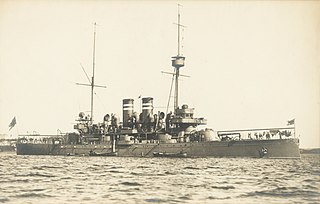
HSwMS Wasa was a Äran-class coastal defence ship that served with the Swedish Navy. The vessel served in the front line for substantially less time than the rest of the class. A development of Dristigheten, the Äran class mounted the same 21 cm (8.3 in) main guns, but differed in the layout of the secondary armament. Wasa was launched in 1901 and served as part of the coastal defence fleet, including taking part in neutrality patrols during the First World War. The ship was retired from front-line service in 1924 and withdrawn from active service in 1940, thereafter acting as a decoy and, from 1951, a damage control training ship. Wasa was sold to be broken up in 1960.
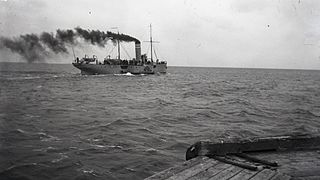
Apostol Paviel was a passenger-cargo, sidewheel steamer built for a Russian shipping company. During World War I, it was requisitioned by the Imperial Russian Navy and converted into a minesweeper. In 1918, it was handed over to the Red Finns by the Bolsheviks, captured by the Whites, and sold to Estonia. In the Estonian Navy, it was renamed Ristna. Along with other Estonian vessels, it was taken over by the Soviet Union in 1940. The ship survived World War II and appeared in Soviet films. It was scrapped in 1958.

Apostol Piotr was a passenger-cargo ship, a side-paddle steamer built for a Russian shipping company. During World War I, it was requisitioned for the needs of the Imperial Russian Navy and converted into a minesweeper. In 1918, it was handed over by the Bolsheviks to the Red Finns, captured by the Whites, and sold to Estonia. In the Estonian Navy, it was named Suurop. Along with the other Estonian vessels, it was taken over by the Soviet Union in 1940. It sank on a mine on 11 August 1941.

Paraguay is a Humaitá-class river gunboat of the Paraguayan Navy. Launched in 1930, it participated in the Chaco War, transporting soldiers to the front. After the war, it took part in numerous coups d'état. In 1972, it was withdrawn from the Armada Nacional as a combat ship and has since served as a training and representational hulk.
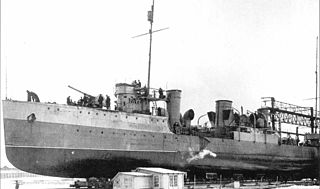
Wambola was a destroyer of the Estonian Navy during the interwar period, originally a Russian Lejtienant Iljin-class ship. Previously, it was known as the Russian Kapitan I ranga Miklucha Maklai during World War I, later the Soviet Spartak, and subsequently the Peruvian Almirante Villar. The construction of the vessel began in 1914 for the Imperial Russian Navy, launched in 1915, and entered service in 1917 under the name Kapitan I ranga Miklucha Maklai. It avoided capture by the Germans by fleeing Helsingfors during the Ice March. The ship was taken over by the Bolshevik navy and renamed Spartak. During the conflict against Estonia, it participated in landing and mining operations. In December 1918, it was captured by the Royal Navy and handed over to the Estonians. In the Estonian Navy, it was named Wambola. During the Estonian War of Independence, it took part in operations against the Bolsheviks in the waters of the Gulf of Finland and in operations against the Baltische Landeswehr in Riga. After the war, it made occasional diplomatic visits. In 1933, due to high maintenance costs, it was sold to Peru. In the Peruvian Navy, it was named Almirante Villar. It did not manage to participate in the Colombia–Peru War but took part in battles against Ecuador in 1941. During World War II, it served in patrol duties and was decommissioned in 1954.




















